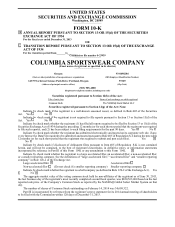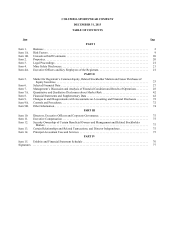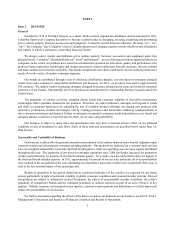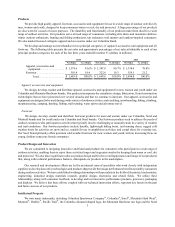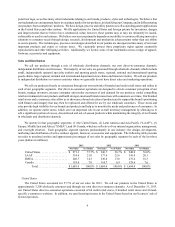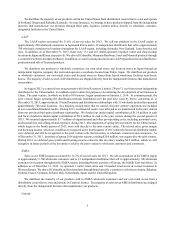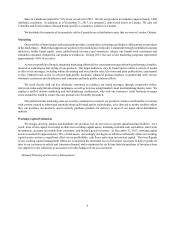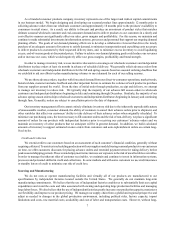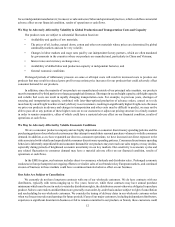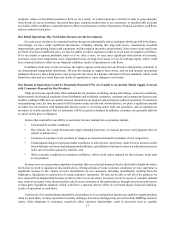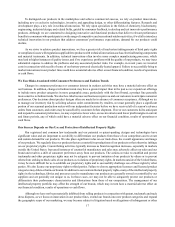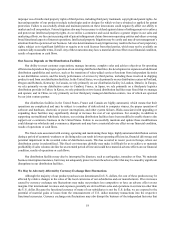Columbia Sportswear 2013 Annual Report Download - page 14
Download and view the complete annual report
Please find page 14 of the 2013 Columbia Sportswear annual report below. You can navigate through the pages in the report by either clicking on the pages listed below, or by using the keyword search tool below to find specific information within the annual report.10
Our business strategies and related increased expenditures could also cause our operating margin to decline if we are
unable to offset our increased spending with increased sales or gross margins, or comparable reductions in other operating
costs. If our sales or gross margins decline or fail to grow as planned and we fail to sufficiently leverage our operating
expenses, our profitability will decline. This could result in a decision to delay, reduce, modify or terminate our strategic
business initiatives, which could limit our ability to invest in and grow our business and could have a material adverse effect
on our financial condition, results of operations or cash flows.
Initiatives to Upgrade Our Business Processes and Information Technology Infrastructure Involve Many Risks Which
Could Result In, Among Other Things, Business Interruptions and Higher Costs
We regularly implement business process improvement initiatives to optimize our performance. Our current business
process initiatives include plans to improve business results through standardization of business processes and technologies
that support our supply chain and go-to-market strategies through implementation of an integrated global enterprise resource
planning ("ERP") software solution and other complementary information technology systems over the next several years.
Implementation of these solutions and systems is highly dependent on coordination of numerous contractors and software
and system providers. The interdependence of these solutions and systems is a significant risk to the successful completion
of the initiatives and the failure of any one contractor or system could have a material adverse effect on the implementation
of our overall information technology infrastructure. We may experience difficulties as we transition to these new or upgraded
systems and processes, including loss of data, delayed shipments, decreases in productivity as our personnel implement and
become familiar with new systems, increased costs and lost revenues. In addition, transitioning to these new or upgraded
systems requires significant capital investments and personnel resources. Difficulties in implementing new or upgraded
information systems or significant system failures could disrupt our operations and have a material adverse effect on our
capital resources, financial condition, results of operations or cash flows.
We expect implementation of this new information technology infrastructure to have a pervasive impact on our business
processes and information systems across a significant portion of our operations. As a result, we will experience significant
changes in our operational processes and internal controls as our implementation progresses, which in turn will require
significant change management, including training of our personnel. If we are unable to successfully manage these changes
in order to implement these systems, including harmonizing our systems, data, processes and reporting analytics, our ability
to conduct, manage and control routine business functions could be negatively affected and significant disruptions to our
business could occur. In addition, we could incur material unanticipated expenses, including additional costs of
implementation or costs of conducting business. These risks could result in significant business disruptions or divert
management's attention from key strategic initiatives and have a material adverse effect on our capital resources, financial
condition, results of operations or cash flows.
We Rely on Our Highly Customized Information Management Systems
Our business is increasingly reliant on information technology. Information systems are used across our supply chain
and retail operations, from design to distribution and sales, and are used as a method of communication among employees,
with our subsidiaries and liaison offices overseas and with our customers and retail stores. We also rely on our information
systems to allocate resources, pay vendors and collect from customers, manage product data, develop demand and supply
plans, forecast and report operating results and meet regulatory requirements. System failures, breaches of confidential
information or service interruptions may occur as the result of a number of factors, including our failure to properly maintain
systems redundancy or to protect, repair, maintain or upgrade our systems, computer viruses, programming errors, hacking
or other unlawful activities by third parties, and disasters. Any breach or interruption of critical business information systems
could have a material adverse effect on our financial condition, results of operations or cash flows.
Our legacy ERP, product development, retail point-of-sale and other systems, on which we currently manage a
substantial majority of our business activities, are highly customized. As a result, the availability of internal and external
resources with the expertise to maintain these systems is limited. Our legacy systems may not support desired functionality
for our operations and may inhibit our ability to operate efficiently, which could have an adverse effect on our financial
condition, results of operations or cash flows. As we transition from our legacy ERP systems to new ERP systems and
supporting systems and third-party systems that interface with our new ERP systems, certain functionality and information
from our legacy systems may not be fully compatible with the new systems. As a result, temporary processes may be
required, including manual operations, which could significantly increase the risk of human errors in information used by


